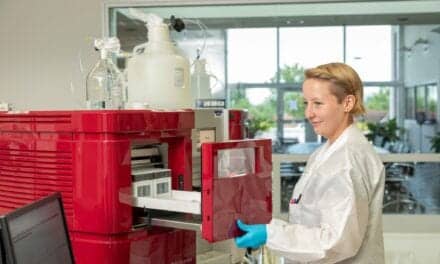Beckman Coulter, Brea, Calif has received FDA emergency use authorization (EUA) for its Access Interleukin-6 (IL-6) assay, a fully automated immunoassay designed to detect IL-6 levels in serum and plasma which can be used to aid physicians identifying a severe inflammatory response and determining the risk of intubation with mechanical ventilation in covid -19 patients.
IL-6 is a multifunctional cytokine that may promote inflammation in certain clinical conditions. Preliminary studies have shown that the IL-6 level is elevated in patients with severe covid-19, and IL-6 may contribute to the severe inflammatory response, also sometimes referred to as cytokine storm.1
“Our goal is to keep patients off the ventilator. IL-6 can help us treat the patient before they need a ventilator. The side effect of this is that we are able to reduce the number of patients on ventilators to preserve capacity if needed in a hospital,” says Joshua Hayden, PhD, DABCC, Chief of Chemistry, Norton Healthcare. “Any time you can have more objective measures, such as testing with IL-6 to predict which patients are going to get worse, it is helpful. I highly encourage places that have to make rationing decisions to use markers such as IL-6 to assist them.”
“We have learned that monitoring IL-6 levels in COVID-19 patients has become an extremely important factor in the management of these individuals, in conjunction with clinical findings and the results of other laboratory testing,” says Mao Eniang, professor and head of emergency medicine, Ruijin Hospital; Medical School of Shanghai Jiao Tong University. “Clinical cases and data suggest that cytokine storms are accompanied by high expression of IL-6 protein. We have also seen that cytokine storms, characterized by elevated IL-6 levels, may be a key factor in the deterioration of patients with severe covid-19.2,3While cytokine storms can be the result of many types of bacterial or viral infections, burns, surgical wounds, and other diseases, they develop differently depending upon the clinical scenario.”
In covid-19 patients, pulmonary inflammation makes oxygenation more difficult and can eventually lead to acute lung injury, pneumonia, or acute respiratory distress syndrome (ARDS), among other conditions. Accumulating evidence suggests that a subgroup of patients4,5with severe covid-19 experience increased levels of IL-6, and studies recommend6,7identification and treatment of hyperinflammation using existing, approved therapies with proven safety profiles to address the immediate need to reduce the rising mortality.9Early studies have shown that, in conjunction with other clinical findings, Access IL-6 testing results could guide patient management by identifying patients at risk for intubation with mechanical ventilation.
“An assay that helps identify patients at risk for respiratory failure and intubation in the care pathway has the potential to significantly improve covid-19 patient care and outcomes,” says Shamiram R. Feinglass, MD, MPH, chief medical officer for Beckman Coulter. “Access IL-6 is used to assist in identifying severe inflammatory response in patients with confirmed covid-19 illness to aid in determining the risk of intubation with mechanical ventilation. In conjunction with clinical findings and the results of other laboratory testing, this assay provides clinicians with vital information enabling them to make decisions on how to manage these critically ill patients.”
For more information, visit Beckman Coulter.
References
1. Liu T, et al. The potential role of IL-6 in monitoring severe case of coronavirus disease 2019. Posted on medRxiv on March 10, 2020. Available at https://www.immunology.ox.ac.uk/covid-19/literature-digest-old/the-potential-role-of-il-6-in-monitoring-severe-case-of-coronavirus-disease-2019.
2. Ruan Q, Yang K, Wang W et al. Clinical predictors of mortality due to COVID-19 based on an analysis of data of 150 patients from Wuhan, China. Intensive Care Med. 2020;46:846–848. doi: 10.1007/s00134-020-05991-x.
3. Maurizio C, Piovani D, Brunetta E, et al. Early predictors of clinical deterioration in a cohort of 239 patients hospitalized for covid-19 infection in Lombardy, Italy. J Clin Med.2020;9(5):1548. doi: 10.3390/jcm9051548.
4. Zhou F, Yu T, Du R, et al, Clinical course and risk factors for mortality of adult inpatients with COVID-19 in Wuhan, China: a retrospective cohort study. Lancet.2020;395(10229):1054–1062. doi: 10.1016/S0140-6736(20)30566-3.
5. Wan S, Yi Q, Fan S, et al, Characteristics of lymphocyte subsets and cytokines in peripheral blood of 123 hospitalized patients with 2019 novel coronavirus pneumonia (NCP). Posted on medRxiv February 11, 2020. Available at https://www.medrxiv.org/content/10.1101/2020.02.10.20021832v1.
6. National Health Commission and State Administration of Traditional Chinese Medicine. Diagnosis and Treatment Protocol for Novel Coronavirus Pneumonia. Released March 3, 2020. Available at https://www.who.int/docs/default-source/wpro—documents/countries/china/covid-19-briefing-nhc/1-clinical-protocols-for-the-diagnosis-and-treatment-of-covid-19-v7.pdf?sfvrsn=c6cbfba4_2.
7. Bhimraj A, Morgan RL, Shumaker AH, et al. Infectious Diseases Society of America Guidelines on the Treatment and Management of Patients with COVID-19. Clin Infect Dis.2020;ciaa478. doi: 10.1093/cid/ciaa478.
8. Mehta P, McAuley DF, Brown M, et al. COVID-19: consider cytokine storm syndromes and immunosuppression. Lancet.2020;395(10229):1033–1034. doi: 10.1016/S0140-6736(20)30628-0.





